Peagle
Canis lupus
Most Peagles love playing with children and can be very gentle and affectionate!
Advertisement
Peagle Scientific Classification
- Kingdom
- Animalia
- Phylum
- Chordata
- Class
- Mammalia
- Order
- Carnivora
- Family
- Canidae
- Genus
- Canis
- Scientific Name
- Canis lupus
Read our Complete Guide to Classification of Animals.
Peagle Conservation Status
Peagle Facts
- Fun Fact
- Most Peagles love playing with children and can be very gentle and affectionate!
- Temperament
- Fun-loving and gentle
- Diet
- Omnivore
Peagle as a Pet:
- General Health
- Energy Level
- Shedability
- Trainability
- Intelligence
- Tendency to Chew
- Size
- Family and kid friendliness
- Yappiness / Barking
- Moderate
- Separation Anxiety
- Moderate
- Preferred Temperature
- Average climate
- Exercise Needs
- Moderate
- Friendly With Other Dogs
- Moderate
- Pure bred cost to own
- $400 to $1,000
- Dog group
- Non-sporting
- Male weight
- 13-18 lbs
- Female weight
- 13-18 lbs
This post may contain affiliate links to our partners like Chewy, Amazon, and others. Purchasing through these helps us further the A-Z Animals mission to educate about the world's species.
View all of the Peagle images!
Peagles enjoy being the center of attention. This can make them a very entertaining breed to own.
Peagles are a hybrid dog breed created by breeding a Pekingese and a Beagle. They are generally very affectionate and playful, though their exact temperament can vary based on the specific mix of genes they inherit from the Beagle and Pekingese parents. The appearance also varies based on their genes; some have short hair like a Beagle, while others have long hair like a Pekingese. They are also well-known for their floppy ears and small round heads. They are sometimes referred to as Peagle Hounds. If you’re considering adoption, a Peagle is a great breed to bring home!
See all of our expert product reviews.
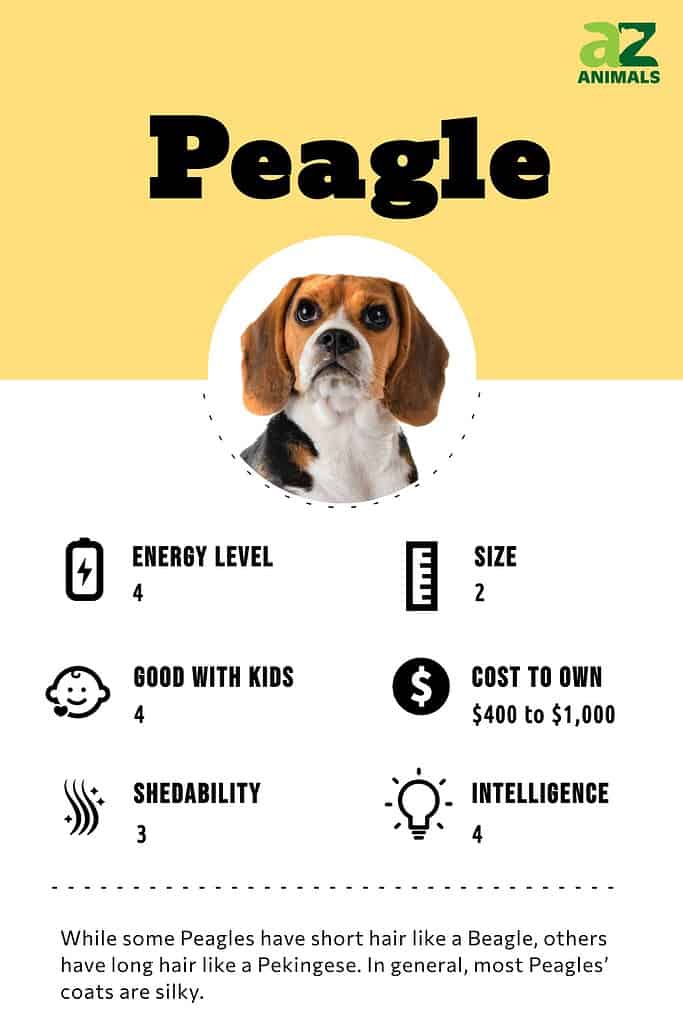
3 Pros and Cons of Owning a Peagle
| Pros! | Cons! |
|---|---|
| Even-tempered: These are generally good-tempered and friendly dogs. | Not hypoallergenic: Peagles shed a lot and will require daily brushing. |
| Good family pet: Peagle Hounds can make an excellent family pet and know how to be gentle with children. | Not as predictable: Since Peagles are a mixed breed, it’s not as easy to predict their appearance or temperament as it is with purebred dogs. |
| Easy to train: Due to the Peagle’s intelligence training is relatively easy. | Barking: Peagles often bark at unknown individuals who come to a door. |

The Peagle is a friendly, even-tempered breed.
©SuJo Studios/Shutterstock.com
Evolution and Origins
Like many hybrid dogs, the Peagle’s origins are difficult to trace, however it’s likely that the breed was developed in the U.S. during the 1990s when crossbreeding to create designer dogs took off.
The Peagle’s parent breeds both have long lineages. The Beagle’s history is believed to date back to 5th century Greece when they assisted in hunts for foxes, rabbits, and other small prey. These hound dogs were popular from the 1500s in England, hunting in packs in search of deer, rabbits, and foxes.
The Pekingese was originally bred to be companions to royalty in China during the Tang dynasty. Referred to as the “lion dog” due to the legend that they once were that large, these dogs continue to be considered sacred or lucky in China.
Health and Entertainment for your Peagle
See all of our expert product reviews.

The Peagle’s parent breed the Pekingese has a long lineage.
©T.Den_Team/Shutterstock.com
Size and Weight
Peagles are a small dog breed. Full-grown males and females weigh between 13 and 18 pounds. Both males and females are between 6 and 16 inches tall. There is some variation between the sizes of each dog depending on the specific mix of genes they inherit from their Pekingese and Beagle parents.
| Height (Male) | 6 to 16 inches |
| Height (Female) | 6 to 16 inches |
| Weight (Male) | 13 to 18 pounds |
| Weight (Female) | 13 to 18 pounds |
Common Health Issues
Before you bring home a new dog, it is important to have an understanding of some of the potential health issues that this breed may face. However, just because the health concerns outlined below are more common in Peagles, it doesn’t mean that your dog will develop all of them or even one of them. It can just help you know what to be on the lookout for.
One potential health concern for these dogs is patellar luxation. Patellar luxation is a slipped kneecap that shifts out of its correct position as the dog walks. You may notice that your dog’s walking looks abnormal, and if so, you should schedule a visit with the veterinarian. Surgery may be performed in some cases.
Another issue to be on the lookout for is epilepsy. This is a seizure disorder that is the most commonly diagnosed chronic neurological disorder among dogs. Dogs having a seizure may lose voluntary control of their body. There are also other types of seizures to look out for, so be sure to consult with your veterinarian if you suspect your Peagle may be having seizures.
Finally, some of them may also develop brachycephalic obstructive airway syndrome or BOAS. This syndrome also impacts their parent breed Pekingese and dogs who have short noses, and dogs with more severe BOAS may have more trouble breathing or digesting properly.
To review, some common health concerns of these dogs include:
- Patellar luxation
- Epilepsy
- Brachycephalic obstructive airway syndrome (BOAS).

Like parent breed Pekingese, Peagles are prone to BOAS.
©Sasa Dzambic Photography/Shutterstock.com
Temperament
These dogs are known for their even temperament. They have very fun-loving personalities and their traits make them excellent family dogs. They are gentle with children and enjoy playing together. However, while most Peagles are like Beagles in this regard, there are a few that are more like their Pekingese parent and don’t like the rougher way some children may handle them.
Many Peagles are less trusting of strangers. They often bark when they see an unknown or untrusted person. Some of them may also engage in behaviors to chase people or other animals.

Peagles are generally gentle with children and make excellent family dogs.
©cynoclub/Shutterstock.com
How to Take Care of a Peagle
Peagles are a unique dog breed. Keep their personality, nutritional needs, exercise needs, and other important information in mind as you plan how to care for your dog.
The Best Dog Food for Peagles
Luckily, the range of health conditions they tend to experience is rather limited. So your Peagle will likely thrive on any number of quality dog food options, but it’s still a good idea to find something that minimizes the risk or symptoms of bad knees due to patellar luxation.
These dogs should be fed high-quality dog food. Consult with your veterinarian to determine the best dog food for your pup. Generally speaking, the dog should eat between ½ and 1 cup of food each day. The exact amount your dog will need will vary based on a variety of factors including his or her weight, age, activity level, metabolism, and any medical concerns.
Puppies have smaller stomachs than their adult counterparts. This means that they will need to eat smaller, more frequent meals throughout the day. Puppies should be fed between three to four times until they are at least six months old. After that time, switching to just two meals each day should be fine. Consult with your veterinarian if you are unsure which food is best for your Peagle puppy or how many times it should be fed each day.
The A-Z Animals’ preference of the best dog food for Peagles is Holistic Select Natural Dry Dog Food, Chicken Meal & Rice Recipe.
Since your Peagle’s knee caps may be vulnerable to patellar luxation, we’re fans of this kibble’s levels of glucosamine, proven to help dogs’ joints. The chicken recipe with pork is fortified with brown rice for healthy fiber for your dog’s digestion. It also includes thiamine and pyridoxine, important nutrients for the nervous system and neural function in this dog prone to seizures.
Check out Holistic Select Natural dog food on Chewy and Amazon.
- Chicken and brown rice recipe
- Promotes balanced nutrition, immune health, and regularity
- Contains probiotics, prebiotics, antioxidants, and dietary fiber
Maintenance and Grooming
A Peagle’s coat and overall appearance will vary based on whether they inherit more of the Beagle genes or more of the Pekingese genes. Some of these dogs have long coats, while others have shorter coats. Although, in general, most Peagles’ coats are silky. To keep their coating looking its best and free of dirt and debris, it is important to brush the dog daily or several times a week. Peagle Hounds are not a hypoallergenic breed, and they shed a fair amount.
These dogs will also need to be bathed as needed, and you should try to keep the area beneath their eyes clean to prevent staining.
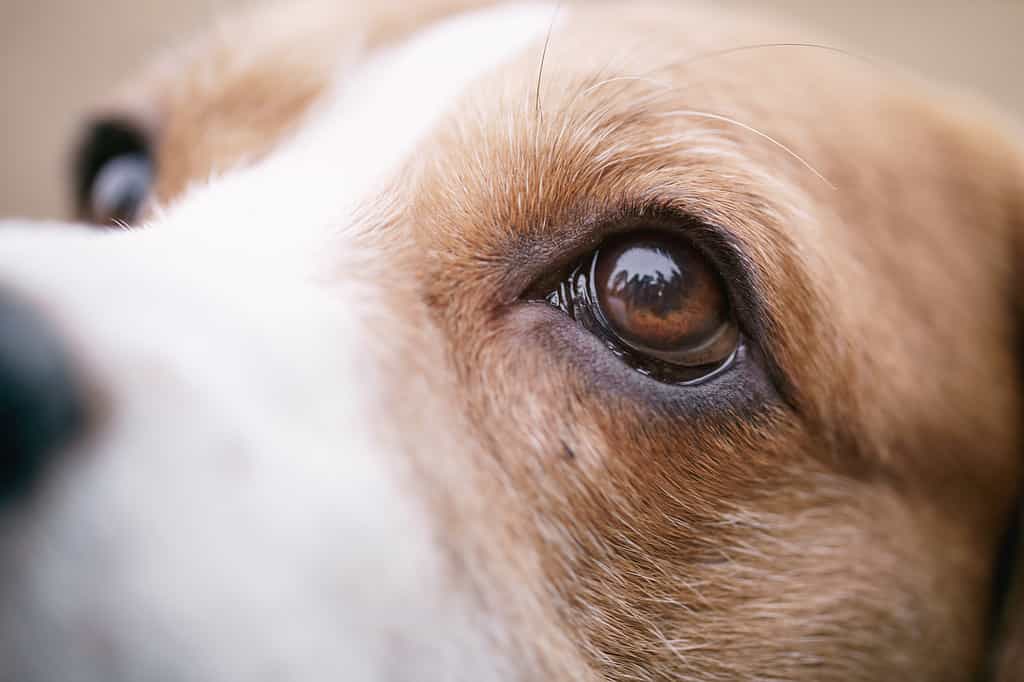
To avoid staining, keep the under-eye area of your dog’s face clean.
©GCapture/Shutterstock.com
Training
These dogs have a very high intelligence level. This generally makes them easier to train. They will respond best to positive training methods. With their Beagle genes, many Peagles have an innate hunting sense. With proper training, this sense and skill can be built up and improved. Owners may consider engaging in special training sessions or seeking out training schools to help their Peagle develop their sniffing and chasing instincts.
In addition to training the dog from an early age, early socialization is also important. Schedule playdates with other dogs and bring your dog with you to expose them to different situations and people.
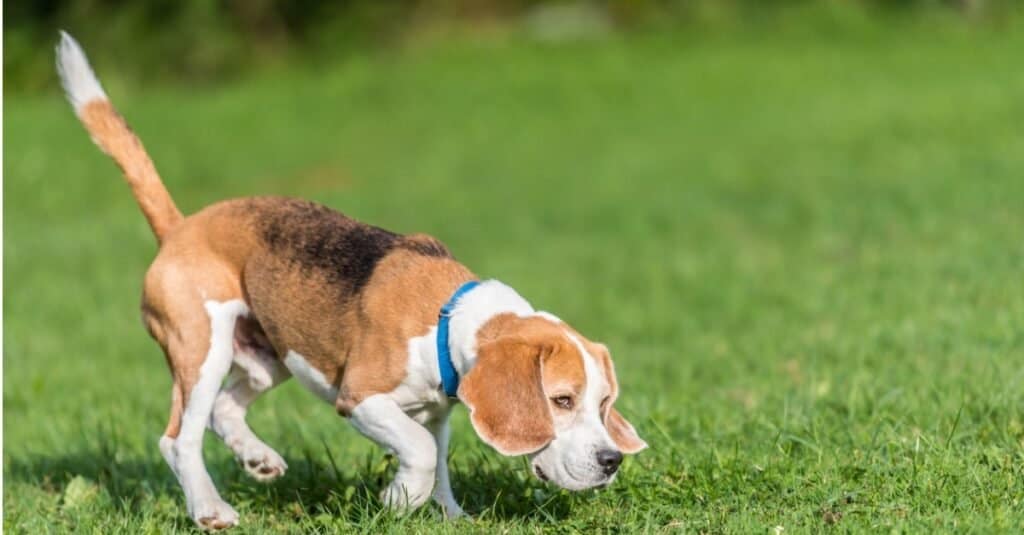
Peagles inherit an innate hunting sense from their Beagle parent.
©iStock.com/K_Thalhofer
Exercise
Peagles should be given daily exercise to keep them healthy and meet their activity needs. Going on long walks with your Peagle or scheduling some playtime in a fenced-in backyard are two examples of ways to help make sure he gets the activity he needs. Be sure to also have plenty of toys for fun indoor play sessions as well.
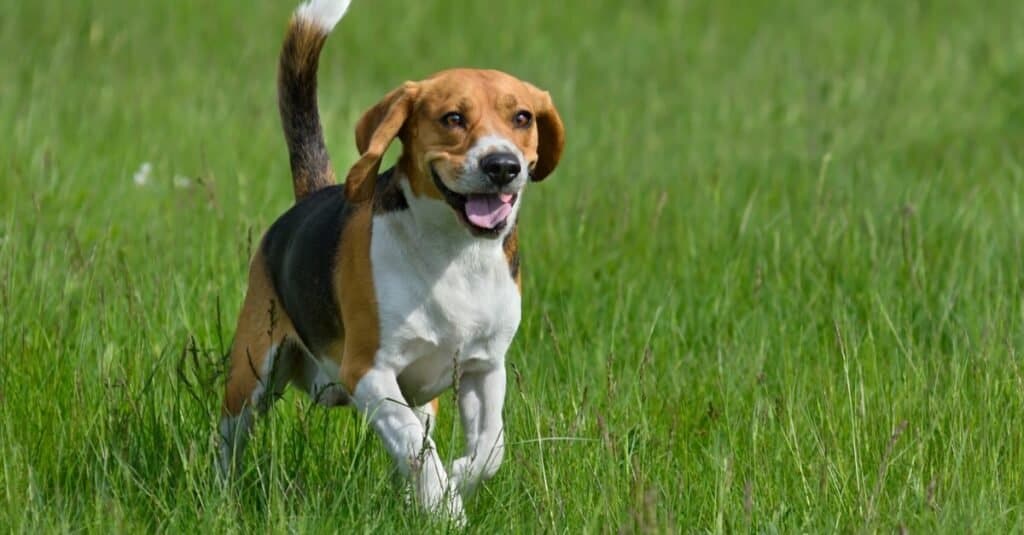
Like Beagles, Peagles should be given daily exercise.
©eAlisa/Shutterstock.com
Puppies
These puppies are very small and could easily be injured if not handled properly. If you are bringing home a small puppy, make sure young children are kept away from the dog until he becomes stronger and the children understand how to interact with a dog appropriately. Take care to begin training and socializing a puppy from a very early age. This will help him understand expectations and how to act in a variety of situations.
A puppy will require a crate, a dog bed, food, toys, water and food bowls, and various other supplies. Consider purchasing all of the supplies you’ll need for your new pup before bringing him home to make sure you are prepared and able to fully enjoy the time once he is home.

Peagle puppies are small and could be hurt if not handled properly.
©Евгений Хабаров/ via Getty Images
Peagles and Children
Most Peagles make good pets for homes with children. They can be playful with a child but also know how to be gentle. Peagles are curious and often seek out attention and love from family members, including children.
Some Peagles may be more like their Pekingese parent and not enjoy attention from children, especially children who may a bit more rough or disruptive. If you notice that your Peagle does not seem to enjoy the attention they are getting from a child, work to help the child learn how to appropriately act with the dog.
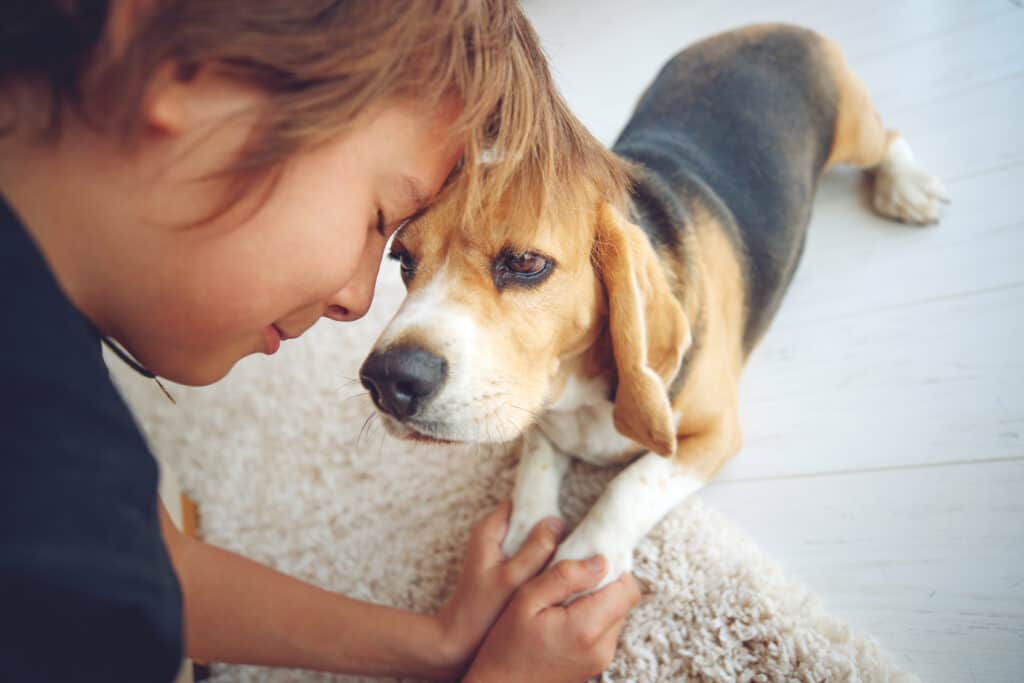
Peagles like Beagles often seek out attention from children and family members.
©Nina Buday/Shutterstock.com
Dogs Similar to the Peagle
Beagle Shepherds, Poogles, and Peekapoos are three breeds that are similar to the Peagle.
- Beagle Shepherd: Beagle Shepherds and Peagles are both hybrid dog breed mixes with one Beagle parent. Both breeds have the floppy ears that of a Beagle and can make a great family pet. Beagle Shepherds are much larger than Peagles. They weigh over 50 pounds while a Peagle only weighs between 13 and 18 pounds.
- Poogle: Poogles are another hybrid breed that also has one parent that is a Beagle. However, unlike Peagles which are mixed with Pekingese, a Poogle is a Beagle that is mixed with a Poodle. Both breeds are relatively easy to train. Grooming of these two breeds can be different as Poogles may require more grooming if they inherit the Poodle’s curly coat.
- Peekapoos: Peekapoos and Peagles both have one parent that is a Pekingese. The other parent for a Peekapoo is a Poodle, whereas Peagles have one Beagle parent. Both breeds are small and weigh less than 20 pounds. They also can both make excellent family pets, especially for homes with older children. Grooming a Peekapoo may be more complicated than grooming a Peagle depending on which parent’s genes are more dominant.

The Poogle is a hybrid between a Beagle and a Poodle.
©iStock.com/PhotoPinoy
Famous Peagles
Do you love Peagles and want to follow some cuties on social media? Check out these Instagram sensations:
- Peanut the Peagle is a fun-loving 3-year-old pup from New York City.
- Peaches the Peagle is an 8-year-old Peagle who loves spending time with his family.
Popular Names for Peagles
Need to find the right name for your Peagle? Consider one of these options:
- Chewy
- Bailey
- Walter
- Gizmo
- Milo
- Elly
- Camila
- Sadie
- Gracie
- Kimi
Peagle FAQs (Frequently Asked Questions)
How much does a Peagle cost to own?
The price to purchase a Peagle can vary depending on the breeder you use and the area where you live. A breeder will typically charge between $400 and $1,000, on average. You may also be able to find a Peagle up for adoption through a local rescue organization or shelter. In this case, you can expect the total price for adoption to be lower, typically only a few hundred dollars.
Don’t forget to consider the additional costs of ownership in addition to the price you’ll pay to adopt a Peagle Hound or purchase one from a breeder. You’ll need to purchase food, treats, toys, dog beds, a crate, and other supplies for your dog. He’ll also need veterinary care and may require training or other specialized services. Your first year owning the dog will likely be the most expensive, and you may spend between $1,000 and $1,500 or more. The following years of ownership should not be as expensive, but you still should budget to spend between $500 and $1,000 to make sure your dog has everything he’ll need to remain healthy.
How long does a Peagle live?
Peagles typically live between 12 and 14 years.
What is a Peagle?
A Peagle is a hybrid dog breed that is the result of mixing a Pekingese with a Beagle. They are relatively small dogs that only weigh between 13 and 18 pounds when fully grown. Peagles are friendly dogs with a pleasant temperament. They can make good family pets and generally do well with children.
How big will a Peagle get?
Peagles typically weigh between 13 and 18 pounds when fully grown. They are normally between 6 and 16 inches tall.
What does a Peagle look like?
Since Peagles are a mix between a Pekingese and a Beagle, their exact appearance can differ depending on the specific genes they inherit. Some Peagles look more like a Beagle, while others look more like a Pekingese. Peagles can be a variety of colors including brown, black, cream, or a mix of these or other colors. They have round heads with floppy ears.
Is a Peagle a good family dog?
Yes, Peagles make a good family dog. Most love playing with children and can be very gentle and affectionate.
Thank you for reading! Have some feedback for us? Contact the AZ Animals editorial team.
Sources
- Pet Guide, Available here: https://www.petguide.com/breeds/dog/peagle/
- Dog Breed Info, Available here: https://www.dogbreedinfo.com/peagle.htm
- 101 Dog Breeds, Available here: https://www.101dogbreeds.com/peagle.asp
- Pet Keen, Available here: https://petkeen.com/peagle/
- Wag Walking, Available here: https://wagwalking.com/breed/peagle
- How To Train The Dog, Available here: https://howtotrainthedog.com/peagle/


















